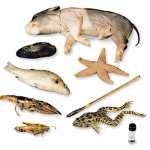Zoology
|
19 november 2013 02:17:54 |
| Variation of serum selenium concentrations in German sheep flocks and implications for herd health management consultancy (Acta Veterinaria Scandinavica) |
|
Tweet Background:
This study was performed to demonstrate the widespread distribution and severity of selenium (Se) deficiency in sheep flocks and to evaluate the impact of influencing factors. In 150 flocks, ten serum samples of adult ewes were analysed for Se concentration. The farmers were interviewed concerning flock size, provision of mineral supplement, predominant form of husbandry (stationary fenced pasture/ transhumance), predominant form of water provision (tap water/ well/ surface water) and predominant soil (sandy, silty/loamy, clay) in the area. The location of the flock was recorded as well as the production stage / season at the time of sampling. Intra-group variation and the validity to analyse pooled samples were tested.
Results:
Pools of five samples correlated well with the mean of individually analysed samples. The intra-group range of serum Se concentration varied enormously (mean 45.4 +/- 18.8 mug Se/l). About 60% of the flocks showed mean serum Se concentrations below 80 mug/l, 37.4% were below 60 mug Se/l, representing a Se deficient stage. Using mineral supplement in general was no key factor for Se status. Stationary flocks on fenced pasture had constantly higher mean serum Se concentrations during breeding (outdoors, August-November), lambing (mainly indoors, December-March) and lactation (outdoors, April-July), whereas flocks practising transhumance had significantly lower Se status, except during lambing. There was no significant correlation between the soil type and the Se status, but flocks in Southern Germany tend to show a lower Se status compared to Central and Northern Germany. Increasing flock size was associated with lower mean serum Se concentrations. In stationary flocks only, the use of surface water was accompanied by significantly lower Se status.
Conclusion:
Se deficiency is widespread in German sheep flocks. More than one third of the flocks showed Se deficiency, indicating the need to optimise the nutritional management. Factors raising suspicion of Se deficiency are large flocks, transhumance during lactation and the breeding season as well as surface water provision in stationary flocks. |
| 89 viewsCategory: Medicine, Zoology |
 Comparison of covariate adjustment methods using space-time scan statistics for food animal syndromic surveillance (BMC Veterinary Research) Comparison of covariate adjustment methods using space-time scan statistics for food animal syndromic surveillance (BMC Veterinary Research)Effects of dehydration and blockade of angiotensin II AT1 receptor on stress hormones and anti-oxidants in the one-humped camel (BMC Veterinary Research) 
|
| blog comments powered by Disqus |
MyJournals.org
The latest issues of all your favorite science journals on one page
The latest issues of all your favorite science journals on one page



